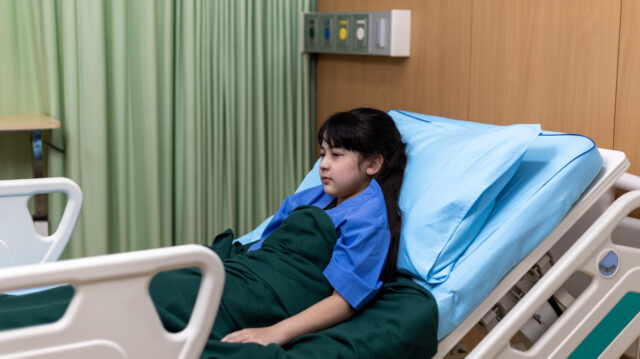Australian Asthma Handbook
The National Guidelines for Health Professionals
Cite
Table
| Severity of Exacerbations | Pattern of exacerbations and symptoms | ||
| Exacerbations less than once every 3 months, and no symptoms between exacerbations | Exacerbations more frequent than once every 3 months, and no symptoms or infrequent symptoms between exacerbations | Symptoms between exacerbations (any of):
| |
Mild Exacerbations quickly resolve with salbutamol | Not indicated | Consider | Indicated |
Moderate–severe ≥1 exacerbation in past year required ED or oral corticosteroids | Consider | Indicated | Indicated |
Life-threatening ≥1 exacerbation required hospitalisation or PICU | Indicated | Indicated | Indicated |
Additional information
ED: emergency department; PICU: paediatric intensive care unit
Table
| Active ingredient | Total daily dose (microg) | ||
Low | Medium | High | |
| Fluticasone propionate | 100 (50 twice daily) | <8 years: >100–200 (e.g. 100 twice daily) | <8 years: >200 |
8–11 years: >100–250 (e.g. 100 twice daily or 125 twice daily) | 8–11 years: >250 | ||
| Ciclesonide | 80 | 160 | >160 |
| Budesonide | 100–200 | >200–400 | >400 |
| Beclometasone (extra-fine particle) | 50–100 | >100–200 | >200 |
Additional information
ICS: inhaled corticosteroid
[ ] Options recommended for first-line use in children, based on current evidence for efficacy and safety
Options not recommended as first-line treatment in children due to delivery device or concerns about systemic effects including potentially greater effects on growth
Recommendation type: Adapted from GINA
Prevention of exacerbations requiring systemic corticosteroid treatment is a key goal of asthma management.
The use of multiple short courses of oral corticosteroids to manage asthma exacerbations in children is associated with a dose-dependent reduction in bone mineral accretion and increased risk for osteopenia.[Kelly 2008] Short courses of oral corticosteroids to manage asthma exacerbations are associated with increased lifetime risk of osteoporosis, pneumonia, cardiovascular or cerebrovascular diseases, cataract, sleep apnoea, renal impairment, depression/anxiety, type 2 diabetes, and weight gain.[Price 2018]
Most benefit of ICS is seen at low-to-medium doses. High doses achieve small improvements in control but greatly increase the rate of local adverse effects.[Adams 2006]
Long-term use of high doses increases the risk of systemic side-effects such as osteoporosis, cataract and glaucoma.[GINA 2025]
Adams NP, Jones PW. The dose-response characteristics of inhaled corticosteroids when used to treat asthma: an overview of Cochrane systematic reviews. Respir Med 2006; 100: 1297-1306.
Global Initiative for Asthma (GINA). Global Strategy for Asthma Management and Prevention, 2025. Available from: www.ginasthma.org
Kelly HW, Van Natta ML, Covar RA, et al. Effect of long-term corticosteroid use on bone mineral density in children: a prospective longitudinal assessment in the childhood Asthma Management Program (CAMP) study. Pediatrics 2008; 122: e53-e61.
Price DB, Trudo F, Voorham J, et al. Adverse outcomes from initiation of systemic corticosteroids for asthma: long-term observational study. J Asthma Allergy 2018; 11: 193-204.
Stepping up
Start ICS if any of the following apply:
Recommendation type: Consensus recommendation
Efficacy of ICS in children
Maintenance treatment with low doses of ICS significantly reduces the risk of asthma exacerbations in children. In a large 3-year clinical trial in children aged 5–10 years with recently diagnosed asthma, maintenance treatment with low-dose ICS (plus SABA as needed) reduced the risk of serious exacerbations by 40%, improved lung function, increased symptom-free days and decreased days lost from school years, compared with SABA only.[Chen 2006]
Most benefit of ICS is seen at low-to-medium doses. High doses achieve small improvements in control but greatly increase the rate of local adverse effects.[Adams 2006]
Safety of ICS in children
At recommended doses, ICSs are generally well tolerated in children.[Rachelefsky 2009; Kapadio 2016]
The use of a spacers with pMDIs reduces oropharyngeal drug deposition and so reduces the risk of local adverse effects (e.g. candidiasis and dysphonia) with ICS.[Lavorini 2020] Topical effects can also be reduced by mouth-rinsing and spitting after inhaling. Immediate quick mouth-rinsing removes more residual medicine in the mouth than delayed rinsing.[Yokoyama 2007]
ICS-related systemic adverse effects in children include suppression of the hypothalamic-pituitary-adrenal (HPA) axis (rare),[Kapadio 2016] short-term linear growth suppression, clinically non-significant effects on bone mineral density, and dose-dependent effects on glucose metabolism.[Kapadio 2016]
A review of long-term clinical trials of recommended doses of inhaled corticosteroids in children found little or no effect on measures of HPA axis function over 12 to 36 months follow-up, and no clinically significant effects on bone mineral density.[Pedersen 2006]
Regular use of ICS in children before puberty is associated with an average reduction of 0.48 cm/year in linear growth rate in the first year of treatment, after which less effect is seen. Growth suppression depends on the dose.[Axelsson 2019]
Uncontrolled asthma also reduces children’s growth and final adult height.[Pedersen 2001]
Adams NP, Jones PW. The dose-response characteristics of inhaled corticosteroids when used to treat asthma: an overview of Cochrane systematic reviews. Respir Med 2006; 100: 1297-1306.
Axelsson I, Naumburg E, Prietsch SO, Zhang L. Inhaled corticosteroids in children with persistent asthma: effects of different drugs and delivery devices on growth. Cochrane Database Syst Rev 2019; 6: CD010126.
Chen YZ, Busse WW, Pedersen S, et al. Early intervention of recent onset mild persistent asthma in children aged under 11 yrs: the Steroid Treatment As Regular Therapy in early asthma (START) trial. Pediatr Allergy Immunol 2006; 17 Suppl 17: 7-13.
Lavorini F, Barreto C, van Boven JFM, et al. Spacers and Valved Holding Chambers-The Risk of Switching to Different Chambers. J Allergy Clin Immunol Pract 2020; 8: 1569-1573.
Pedersen S. Do inhaled corticosteroids inhibit growth in children? Am J Respir Crit Care Med. 2001; 164: 521-35.
Pedersen S. Clinical safety of inhaled corticosteroids for asthma in children: an update of long-term trials. Drug Saf. 2006; 29: 599-612.
Rachelefsky G. Inhaled corticosteroids and asthma control in children: assessing impairment and risk. Pediatrics 2009; 123: 353-66.
Yokoyama H, Yamamura Y, Ozeki T, et al. Effects of mouth washing procedures on removal of budesonide inhaled by using Turbuhaler. Yakugaku Zasshi 2007; 127: 1245-1249.
If symptoms do not resolve, check inhaler technique and adherence, environmental triggers, and review the diagnosis.
If cough is the predominant sign, check clinical response to a treatment trial of ICS after 4 weeks. If cough has not resolved, stop ICS treatment and reconsider alternative diagnoses.
Check:
Recommendation type: Adapted from GINA
Global Initiative for Asthma. Global Strategy for Asthma Management and Prevention, 2025. Available from: www.ginasthma.org/reports.
Recommendation type: Consensus recommendation
Maintenance treatment with a combination of an ICS and a LABA in a single inhaler is approved by TGA for use in children ≥4 years.[Australian PI: fluticasone propionate/salmeterol xinafoate]
This option avoids increasing the ICS dose, while achieving at least equal efficacy.[Vaessen-Verberne 2010]
In children with asthma that is not well controlled with low-dose ICS, adding a LABA is more likely to improve asthma than increasing the ICS dose or adding montelukast to low-dose ICS.[Lemanske 2010, Chauhan 2014, Cividini 2023] However, individual responses vary; some children have a better response to other options.[Lemanske 2010]
In children aged 4–11 years, addition of LABA to ICS does not increase risk of exacerbations,[Stempel 2016] contrary to historical concerns.
Australian Product Information – Pavtide (fluticasone propionate/salmeterol xinafoate) Accuhaler and MDI. [Revised 7 November 2022] Therapeutic Goods Administration (www.ebs.tga.gov.au)
Bisgaard H, Le Roux P, Bjamer D, et al. Budesonide/formoterol maintenance plus reliever therapy: a new strategy in pediatric asthma. Chest 2006; 130: 1733-1743.
Cividini S, Sinha I, Donegan S, et al. Best step-up treatments for children with uncontrolled asthma: a systematic review and network meta-analysis of individual participant data. Eur Respir J 2023; 62: 2301011.
Chauhan BF, Ducharme FM. Addition to inhaled corticosteroids of long-acting beta2-agonists versus anti-leukotrienes for chronic asthma. Cochrane Database Syst Rev 2014; 1: CD003137.
Lemanske R, Mauger D, Sorkness C, et al. Step-up therapy for children with uncontrolled asthma receiving inhaled corticosteroids. N Engl J Med 2010; 362: 975-985.
Stempel DA, Szefler SJ, Pedersen S, et al. Safety of adding salmeterol to fluticasone propionate in children with asthma. N Engl J Med 2016; 375: 840-849.
Vaessen-Verberne AA, van den Berg NJ, van Nierop JC, et al. Combination therapy salmeterol/fluticasone versus doubling dose of fluticasone in children with asthma. Am J Respir Crit Care Med 2010; 182: 1221-1227.
Note on the 2025 recommendation: Maintenance-and-reliever therapy with ICS-formoterol is not approved by TGA for use in the treatment asthma in children younger than 12 years. Future Australian asthma handbook guidance may recommend maintenance-and-reliever therapy for children 6–11 years, depending on the findings of recent and ongoing clinical trials, and on TGA and PBS decisions.
Limited evidence in children 6–11 years suggests that the combination of very low doses of budesonide–formoterol taken as maintenance treatment, with extra doses taken as reliever whenever symptoms occur, is associated with a large reduction in exacerbation rate, compared with the same dose as maintenance treatment with SABA taken as needed for symptoms, and compared with a higher dose of maintenance ICS treatment.[Bisgaard 2006]
Recommendation type: Adapted from GINA
In a systematic review and network analysis of asthma treatment trials in children with asthma uncontrolled while taking ICS alone, medium-dose ICS-LABA was associated with the lowest risk of asthma exacerbations and with improved lung function, compared with medium-dose ICS, higher-dose ICS, or ICS plus LTRA.[Cividini 2023]
Cividini S, Sinha I, Donegan S, et al. Best step-up treatments for children with uncontrolled asthma: a systematic review and network meta-analysis of individual participant data. Eur Respir J 2023; 62: 2301011.
Global Initiative for Asthma. Global Strategy for Asthma Management and Prevention, 2025. Available from: www.ginasthma.org/reports.
Note on the 2025 recommendation: Maintenance-and-reliever therapy with ICS-formoterol is not approved by TGA for use in the treatment asthma in children younger than 12 years. Future Australian asthma handbook guidance may recommend maintenance-and-reliever therapy for children 6–11 years, depending on the findings of recent and ongoing clinical trials, and on TGA and PBS decisions.
Limited evidence in children 6–11 years suggests that the combination of very low doses of budesonide–formoterol taken as maintenance treatment, with extra doses taken as reliever whenever symptoms occur, is associated with a large reduction in exacerbation rate, compared with the same dose as maintenance treatment with SABA taken as needed for symptoms, and compared with a higher dose of maintenance ICS treatment.[Bisgaard 2006]
Recommendation type: Consensus recommendation
Suitable specialists for referral include paediatric respiratory physicians, general paediatricians with a special interest in asthma, or allergists.
Stepping down
Arrange follow-up within 3–6 weeks to reassess asthma symptom control and review the treatment plan.
Recommendation type: Adapted from GINA
Global Initiative for Asthma (GINA). Global Strategy for Asthma Management and Prevention, 2025. Available from: www.ginasthma.org
Do not attempt a step-down at a time when exposure to known symptoms triggers is likely (e.g. in winter when respiratory viruses are prevalent, or in springtime if the child has allergic rhinitis or known sensitisation to seasonal aeroallergens such as pollens).
Seasonal worsening of asthma symptoms is common among children (e.g. in winter months and at the start of the school term).

Medication management
How to manage a child’s mild asthma exacerbations that do not require an ED visit.

Medication management
How to investigate asthma that is not well controlled despite treatment with medium-dose ICS-LABA.